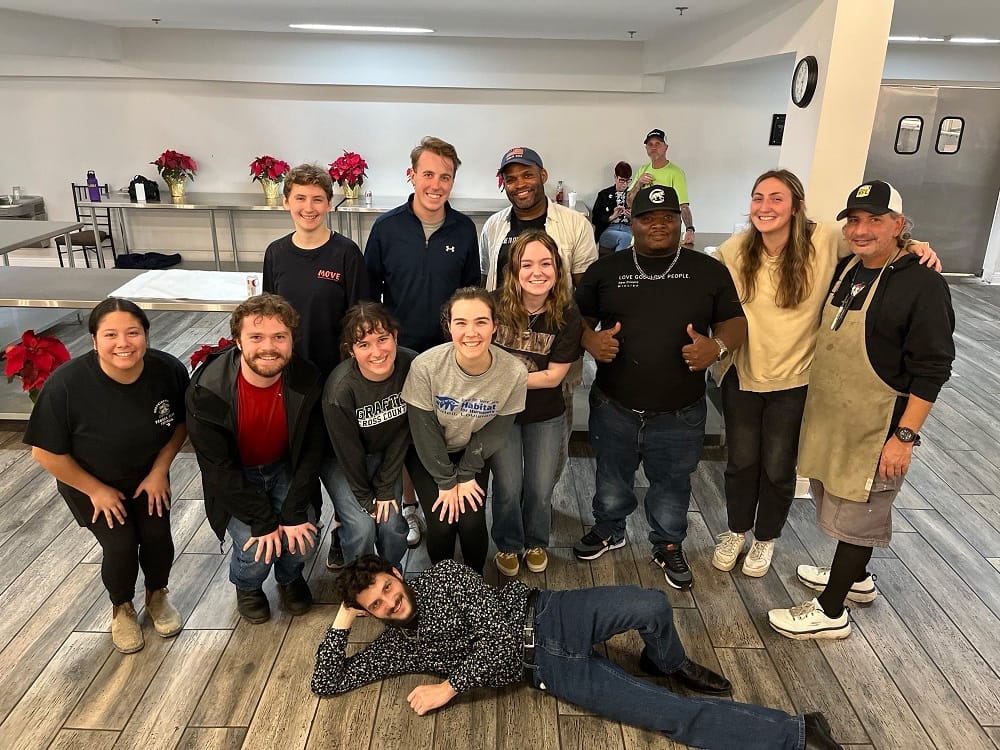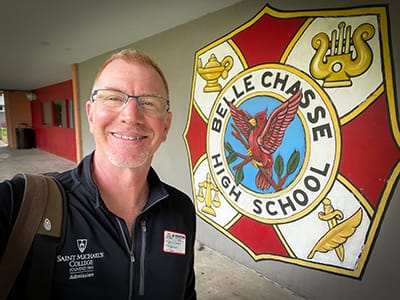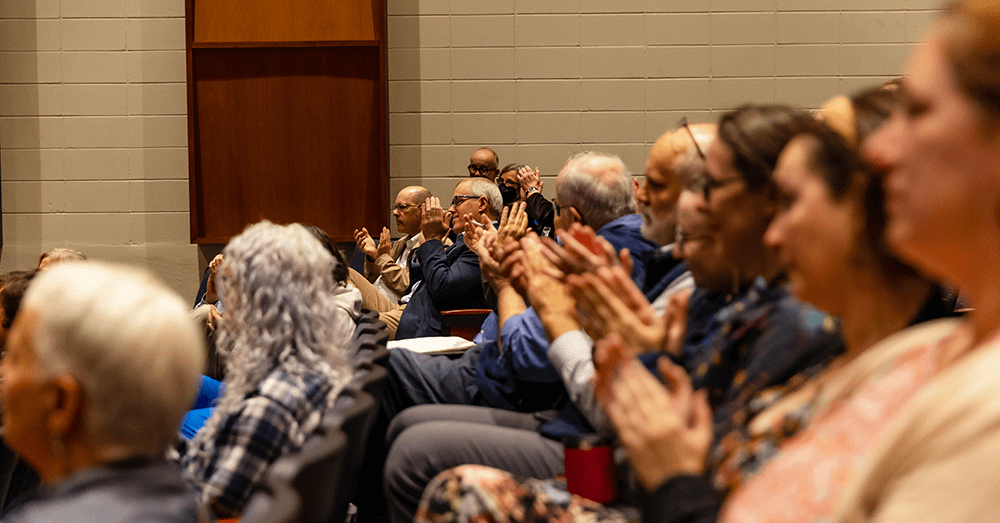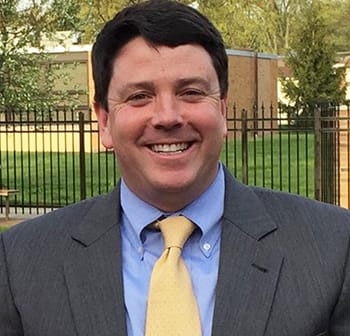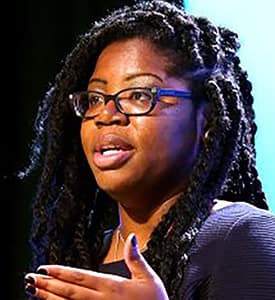Word Garden coaxes out summer research hopes
The first noontime luncheon for this summer’s mentored undergraduate researchers at Saint Michael’s College officially raised the curtain on work that already is impressing trustees and alumni in its early stages.
That was the message from Karen Talentino, vice president for academic affairs, whose office sponsored the outdoor gathering in the Teaching Gardens on Monday, June 6. As at similar luncheons in recent years, these gatherings offer students practice communicating clearly about their research while supporting and learning from one another in the company of faculty mentors and other staff who want to spread the word about a growing research culture at the College.
Talentino recounted positive feedback from trustees and alumni who were on campus the past weekend for Reunion with a chance to tour labs and meet researchers. “They want me to convey how impressed they are,” she said, noting that many of those trustees and alumni are financial supporters of students’ projects.
Students mingled with mentors and staff at picnic tables in conversation over barbecued chicken, sides and desserts before Talentino shared words of context and encouragement and introduced an activity in the Word Garden to coax early-draft “elevator speech” synopses of projects from students.
“When you go home or apply for graduate school or talk to a reporter, you need to be able to say what important question you asked, how you approached it, the methods you used, what you were looking to find out, what you did find out and what’s next,” she said. With gratitude, she reviewed the multiple chief funding sources for summer research, including the Trustee Scholar Program, the Alumni Fund for Undergraduate Research, endowed funds by alumni or former faculty such as Hartnett and Gianni and Green-Bean, external grants from the National Science Foundation or National Institutes of Health, the Fish and Wildlife Service, Vermont Genetics Network and NASA. Her office closely tracks undergraduate research trends among peers and competitor schools, and “ours is one of the best for student research I think,” Talentino said. “We’re small enough that we can see ourselves as a community of scholars in a way not possible at larger school.”
“Set your sights high,” she said.
With that, everyone headed to the Word Garden, each student assigned to pick a word-bearing stone signifying something important about his or her research.
Carly Anderson’18 , biology major from Whitefish, MT, started by explaining her VGN/NIH funded work with Ruth Fabian-Fine on spiders’ central nervous systems. Elizabeth Consentino’18 of Waitsfield, VT and Ryan Stapleton ’18 of Washington Towns, NJ, then described their timely news-related research on the recent scandal in Vermont at Jay Peak Resort surrounding the EB-5 visa program for foreign entrepreneurs. Their mentor is Brosh Teucher of the business faculty.
Ross Henry ’17 of Chagrin Falls, OH, working with Anjanette DeCarlo of Environmental Studies to create a database of locations that are getting destroyed and altered due to climate change, picked the word “north” on a Word-Garden rock since the primary affected area in his study is Alaska.
One among several students doing research on bobcat genetics with Dagan Loisel of the biology faculty chose two words, “risk” and “inspire” since, she explained, students take risks to do research after being inspired by others, and in turn, hope to inspire others. Jennifer Toner of Long Valley, NJ, exploring aspects of nervous systems in leeches with biology’s Adam Weaver, chose “bug” because “it’s close enough to a leech in my book.”
A little outside the pure science realm, Katie Petrozzo ’17 of Huntington, NY, left, spoke of her work with philosophy Professor Crystal L’Hote from the neuroscience faculty on “Free Will and Responsibility in the Neuroscientific Age,” a topic which is requiring her to “think” – hence her rock-word.
Ben Cohen – “not the ice cream guy” he clarified to laughs – is an environmental studies major from Hebron, CT, shown at right, working with faculty mentor Farrah Fatemi. He chose “organic” and “root” as his words for the “obvious reasons” that he’s studying plant root and fungal networks that connect and affect plant growth. Another Fatemi student chose “care” to signify her study of land use management related to phosphorus retention, because “I care about dirt!”
Molly Rausch and Carly Anderson from the sizeable spider group under Fabian-Fine chose “brain” — “we’re looking at the brains of spiders and I’m using mine quite a bit!”
Myra Alvarez, is working with psychology professor Anthony Richardson on a virtual reality project, hoping in tests to convince subjects that their virtual hands are their actual hands, even though they are not, through movement and touch and illusion. “Person” was her word, cutting to the heart of the whole virtual reality enterprise and its effects on identity.
Erin Burke ’17 of Westford, MA, below left, is working with Jonathan Silverman of the education faculty on ways to empower young girls in the classroom to advocate for themselves and others. Her word was “wonder” — which she said is what she hopes to instill in the girls she meets in classrooms.
Janel Roberge ’12, at right in white sweater, a research assistant with biology’s Declan McCabe in the annual widespread EPSCoR water quality research out of Saint Michael’s labs, chose “wisdom” since “one of the fun parts of our job is imbuing wisdom we have into our little ducklings!” A student working with her on effects of climate change in the lake chose the letters “s” (times two), standing for “suspended solids’ which is what the group often samples.
Emma Timmel ’19 of Gotha, FL, at right, described her work with David Heroux of the chemistry faculty on converting algae to biofuels, and chose the word “grow” since that’s what algae do, plus, she hopes to “grow” as a researcher.
Other projects in the sciences involved chemicals and isotopes as tags for biomarkers, crystal synthesis, DNA binding for prostate cancer therapeutics, computational chemistry to look at dyes through computers and quantum mechanics, synthesis in porous carbon, and much more, under a variety of faculty from biology and chemistry. Julia Snyder’17, working with a UVM researcher and Saint Michael’s alumnus Michael Previs ’99 on heart-disease genetics, chose “create,” because, she said, “I’m often told it’s not an exact science, it’s an art” when doing her type of research.
The most uncommon topic might have been Tyler Lucey, (at left, orange shirt), music major from Longmeadow, MA, studying with William Ellis of the Fine Arts/Music faculty to explore the works of a Syrian composer who lives in Winooski. Lucey had to learn Arabic music theory, he said, and will look at music the composer wrote in Syria and later in Vermont and see what effects Vermont has had in his music.
The final group to share, pictured at right, is continuing the enduring work of many years under Jo-Ellis Monaghan and Greta Pangborn in mathematics and computer science on origami folding for dynamic DNA/RNA nanomachines, through an NSF grant. They chose “colleague” as their rock word “since we’re colleagues.”
Talentino said the Word Garden session might have been the best she’s seen in years of doing it, which shows that “we’re learning how to prepare students better.”
“ You can do all the things you talked about, and each of us is here to help you,” she said.
